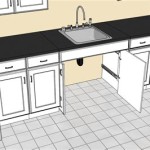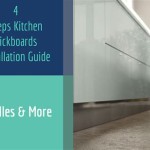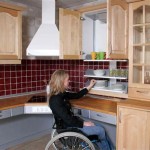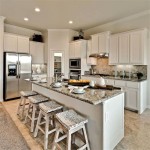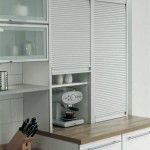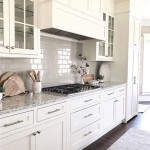How Much Does Spray Painting Kitchen Cabinets Cost?
Revamping a kitchen often includes upgrading the cabinets, and spray painting them is a popular and cost-effective alternative to full replacement. However, understanding the associated costs is crucial for budgeting and making informed decisions. The overall expense is influenced by a variety of factors, ranging from the size and material of the cabinets to the complexity of the project and the chosen professional.
The cost of spray painting kitchen cabinets can vary significantly, typically ranging from $3 to $12 per square foot for professional services. This broad range reflects the numerous variables involved. For example, a small kitchen with simple cabinet designs will naturally be less expensive to paint than a large kitchen with intricate detailing. The condition of the cabinets also plays a significant role; cabinets that require extensive repairs or preparation will incur higher costs.
Furthermore, the chosen painting method significantly impacts the overall expenditure. Spray painting, as opposed to brush or roller application, tends to be more expensive due to the equipment, skill, and time involved in achieving a smooth, factory-like finish. However, the superior finish and durability often justify the higher upfront cost. DIY projects, while seemingly cheaper, can often lead to unforeseen expenses due to mistakes, material waste, and the need for specialized tools. Therefore, a thorough cost-benefit analysis is essential before deciding on the best approach.
Factors Affecting the Cost of Spray Painting Kitchen Cabinets
Several factors combine to determine the final cost of spray painting kitchen cabinets. Understanding these individual elements allows homeowners to better estimate the potential expenses and make informed decisions during the planning phase.
Cabinet Material: The type of material your cabinets are made from directly influences the cost. Solid wood cabinets, while generally more durable, often require more extensive preparation, including sanding and priming, to ensure proper paint adhesion. Laminate or melamine cabinets, on the other hand, present adhesion challenges and may necessitate specialized primers and bonding agents, adding to the material cost and labor time. MDF (Medium-Density Fiberboard) cabinets are typically easier to paint than laminate but may require multiple coats of primer to achieve a smooth, even surface.
Kitchen Size and Cabinet Quantity: The size of the kitchen and the number of cabinets significantly impact the labor and material costs. Larger kitchens with more cabinets naturally require more time for preparation, painting, and reinstallation. This translates directly into higher labor costs. Similarly, a greater quantity of cabinets necessitates a larger volume of paint, primer, and other materials, contributing to the overall expense.
Cabinet Complexity and Design: The design intricacies of the cabinets, such as raised panels, detailed trim, or intricate carvings, increase the complexity of the painting process. These features require more meticulous work, including careful masking and precise application of paint to ensure even coverage and avoid drips or runs. This added complexity inevitably translates into higher labor costs.
Condition of Cabinets: The existing condition of the cabinets is a major cost driver. Cabinets that are in good condition, with minimal dings, scratches, or damage, require less preparation. However, cabinets that have peeling paint, deep scratches, or structural damage will necessitate extensive repairs, including sanding, filling, and potentially even replacing damaged sections. This added preparation time and material cost significantly increase the overall price.
Preparation Work: Proper preparation is essential for achieving a professional and durable finish. This includes removing hardware, thoroughly cleaning the cabinet surfaces, sanding to create a smooth surface for paint adhesion, and applying primer to seal the wood and provide a uniform base for the paint. The amount of preparation work required depends on the condition and material of the cabinets. Neglecting proper preparation can lead to peeling paint, uneven coverage, and a less durable finish, ultimately resulting in higher costs in the long run due to the need for rework.
Paint Type and Quality: The type and quality of paint used also affect the cost. Higher-quality paints offer better coverage, durability, and resistance to chipping and scratching. While these paints may be more expensive upfront, they can save money in the long run by reducing the need for frequent repainting. Additionally, specific paint types, such as acrylic latex or oil-based paints, may be better suited for certain types of cabinets. The choice of paint should be carefully considered based on the cabinet material and the desired finish.
Professional Fees: Labor costs comprise a significant portion of the overall expense. Professional painters typically charge by the hour or by the square foot, depending on the project's complexity. Their fees reflect their experience, expertise, and the quality of their work. While DIY painting may seem like a cheaper option, it can often lead to unexpected costs due to mistakes or the need for specialized tools. Hiring a professional ensures a high-quality finish and can save time and hassle.
Hardware Replacement: While not directly related to the painting process, many homeowners choose to replace the hardware (knobs, pulls, hinges) during a cabinet refinishing project. New hardware can significantly enhance the overall look of the cabinets and complement the new paint color. The cost of hardware varies depending on the style, material, and brand. Budgeting for new hardware is an important consideration when planning a cabinet refinishing project.
Geographic Location: The cost of labor and materials can vary significantly depending on geographic location. Areas with a higher cost of living typically have higher labor rates and material prices. Obtaining quotes from multiple local professionals is essential for comparing prices and finding the best value for your budget.
Cost Breakdown: DIY vs. Professional Spray Painting
A key decision involves choosing between a DIY approach and hiring professional painters. Both options have cost implications that need careful consideration.
DIY Spray Painting Costs: Opting for a DIY approach can initially appear more budget-friendly. However, a comprehensive cost analysis reveals hidden expenses. The initial investment includes purchasing necessary equipment, such as a paint sprayer, respirators, drop cloths, painter's tape, sandpaper, primer, and paint. The cost of these materials can quickly add up, especially if high-quality products are chosen to achieve a professional-looking finish. Furthermore, the time investment should not be underestimated. Preparing the cabinets, applying multiple coats of paint, and cleaning up afterwards can be time-consuming, particularly for those with limited experience. Finally, mistakes can lead to material waste and the need for rework, further increasing the overall cost and potentially nullifying initial savings.
Professional Spray Painting Costs: Hiring professional painters involves a higher upfront cost, but it often yields a more durable and aesthetically pleasing result. Professionals possess the expertise, experience, and specialized equipment necessary to achieve a smooth, even finish. They also handle the preparation work, including cleaning, sanding, and priming, saving homeowners valuable time and effort. While labor costs contribute significantly to the overall expense, the peace of mind knowing that the job is being done correctly and efficiently can be worth the investment. Moreover, professionals often offer warranties on their work, providing added protection against peeling paint or other issues.
A detailed comparison of the costs associated with each option is essential. While DIY may seem cheaper on the surface, the potential for mistakes, the time commitment, and the cost of equipment can quickly erode the savings. Professional painting, while more expensive upfront, offers a higher-quality finish, saves time, and provides peace of mind.
Strategies for Reducing Spray Painting Costs
Even when aiming for a professional finish, several strategies can help to manage the cost of spray painting kitchen cabinets.
Obtain Multiple Quotes: Requesting bids from multiple painting contractors is crucial for comparing prices and ensuring a competitive rate. Provide each contractor with detailed information about the scope of the project, including the number of cabinets, the material, the desired paint color, and any specific requirements. Review each quote carefully, paying attention to the details of the services included and the quality of materials used. Be wary of significantly lower bids, as they may indicate substandard work or the use of inferior materials.
Prepare Cabinets Yourself: While professional painters typically handle the preparation work, some homeowners may choose to undertake certain tasks themselves to reduce labor costs. This can include removing hardware, cleaning the cabinets, and even sanding the surfaces. However, it's crucial to perform these tasks correctly to ensure proper paint adhesion. If you're not confident in your ability to prepare the cabinets adequately, it's best to leave this to the professionals.
Choose Cost-Effective Paint: While high-quality paint is generally recommended for its durability and coverage, there are cost-effective options that can provide satisfactory results. Consult with your painting contractor to explore different paint brands and types that offer a balance of quality and price. Consider using a primer that is specifically designed for the cabinet material to improve paint adhesion and reduce the need for multiple coats of paint.
Consider Painting Only the Cabinet Doors: If the cabinet frames are in good condition and match the desired aesthetic, consider painting only the doors and drawer fronts. This can significantly reduce the overall cost by minimizing the amount of labor and materials required. However, ensure that the painted doors and drawer fronts blend seamlessly with the existing frames.
Avoid Peak Season: Like many home improvement services, painting services are often more expensive during peak season (spring and summer) due to higher demand. Scheduling your project during the off-season (fall and winter) may result in lower labor rates and potentially faster turnaround times.
By implementing these strategies, homeowners can effectively manage the cost of spray painting kitchen cabinets without compromising on the quality of the finish. Careful planning, thorough research, and open communication with painting contractors are essential for achieving a satisfactory outcome within budget.

How Much Does It Cost To Spray Paint Kitchen Cabinets

How Much Does It Cost To Paint Kitchen Cabinets

How Much Does It Cost To Spray Paint Kitchen Cabinets S No 1 Professional Upvcspray Painting

Spray Paint Kitchen Cabinets Costs In 2024 Checkatrade

Cost To Paint Kitchen Cabinets 2024 Data Angi

How Much Does It Cost To Spray Paint Kitchen Cabinets Sketch

How Much Does It Cost To Spray Paint Kitchen Cabinets Sketch

How Much Does It Cost To Paint Kitchen Cabinets In 2024 Spray Repainting

How Much Does It Cost To Spray Paint Kitchens Cabinets Cheshire Upvc Coatings

How Much Does It Cost To Spray Paint Kitchen Cabinets S No 1 Professional Upvcspray Painting
Related Posts

